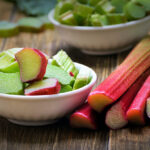Substance in rhubarb cuts cancer cell growth in half, study suggests
 (NaturalHealth365) Parietin, an orange pigment present in various lichen species and the tart vegetable rhubarb, plays a crucial role in absorbing blue light and safeguarding these plants from harmful UV radiation. However, the latest research has yielded even more captivating findings.
(NaturalHealth365) Parietin, an orange pigment present in various lichen species and the tart vegetable rhubarb, plays a crucial role in absorbing blue light and safeguarding these plants from harmful UV radiation. However, the latest research has yielded even more captivating findings.
Multiple studies, including recent ones, have consistently demonstrated the anticancer properties of parietin. These studies have revealed that the compound inhibits the expression of a crucial enzyme vital to cancer cell growth. This body of research underscores the potential of parietin as a promising anticancer agent.
Another great reason to eat your vegetables
During in vitro investigations, researchers at Emory University in Atlanta, Georgia, discovered that parietin killed half of the leukemia cells in a study culture within 48 hours.
In their October 2015 report published in the journal Nature, Emory researchers also discovered that, in animal models, a more potent derivative of this powerful pigment (called S3) cut the growth of lung cancer cells by a factor of three over the course of 11 days.
While obviously lethal to cancer cells, parietin in both dose amounts left healthy cells alone. The same results were seen in cultures of head and neck tumors.
Parietin works by stopping the production of the 6PGD (6-phosphogluconate dehydrogenase) enzyme, one of the drivers for cancer growth. According to Professor Jing Chen of the Winship Cancer Institute – Emory School of Medicine and one of the authors of the report, cancer cells require a certain amount of 6PDGD to grow. Once that amount falls below a certain level, cancer growth will decrease as well.
“This is part of the Warburg effect, the distortion of cancer cells’ metabolism,” Chen said in a recent press release about the study.
The power of nutrition: Starving cancer cells with an extract from rhubarb
The “Warburg Effect,” named after Nobel prize winner Otto Heinrich Warburg, explains how cancer cells get their energy. Warburg was the first scientist to observe that cancer cells obtain fuel anaerobically by glycolysis (followed by fermentation) rather than aerobically, using oxygen like healthy cells do.
In fact, Warburg hypothesized that it is this very change in the metabolism of cells that is the fundamental cause of cancer mutation. Parietin very effectively stops a key enzymatic process within the cancer metabolic chain, leading to cell starvation and death.
The researchers at Emory discovered the cancer-fighting power of parietin in rhubarb after testing close to 2,000 other compounds that were known to inhibit this enzyme to one extent or another. Their goal – since this research is being funded by Big Pharma – is to create a drug.
Could there be a more natural way to access the healing properties of rhubarb?
Conventional drugs to treat cancer often have a link in some way to natural substances. By the time these drugs go to market, however, they have been so synthetically altered that they barely resemble their original source. Of course, the short-term as well as long-term side effects of these drugs are often worse than the effects of the cancer itself.
Natural substances, on the other hand, rely on the delicate yet synergetic relationship between plant compounds and the human body.
“Even if it’s proven that parietin can treat cancer in people, it’s unlikely anyone could eat enough rhubarb to get the benefits,” Dr. Hayley Frend of Cancer Research UK stated in a recent article about the discovery.
This kind of thinking discounts the benefits of whole plant medicine and the many other ways that rhubarb, in particular, is a powerhouse for immune support and cancer prevention:
● Rhubarb is a good source of vitamin C, vitamin K, calcium, manganese, magnesium, and dietary fiber
● Rhubarb contains ferulic acid, a potent antioxidant that aids in synthesizing vitamins C and E and has been shown to have an especially protective effect against skin cancer
● Rhubarb contains the polyphenolic compound resveratrol, which has been shown to have an anti-inflammatory effect. Like melatonin, resveratrol is also an aromatase inhibitor, making it a powerful preventer for estrogen-dominant breast cancers
● In particular, rhubarb also contains (Z)-3,5,4-Trimethoxystilbene, a component of resveratrol that can arrest the growth of human colon cancer cells
● Rhubarb contains anthraquinones, organic aromatic compounds which researchers have found to have a protective effect against mercury-induced kidney failure
● Two anthraquinones found in rhubarb, rhein, and emodin, have particular anticancer effects. In a 2012 study, researchers discovered that rhein-induced cancer cell death in chemo-resistant HER2/neu breast cancer cells. Emodin is most commonly used as a laxative but has also been found to suppress breast and cervical cancer proliferation
● Turkish Rhubarb root is one of the main ingredients in the anticancer Essiac tea formula
It is commendable when traditional research facilities investigate and embrace the cancer-fighting properties of natural herbs, foods, and substances. It is saddening, though, when these facilities do so for the sole aim of creating a new drug to add to the health-damaging cadre of cancer pharmaceuticals that already saturate the halls of Western medicine.
There is a way to get the benefits of rhubarb and its many healing components in a natural way, however. Making a tea with dried roots, adding rhubarb stems (not the leave as they are toxic) for juicing, and supplementing with capsules or extract are all-natural yet effective ways of receiving all the wonderful health benefits rhubarb has to offer.
Sources for this article include:
NIH.gov
News.emory.edu
Express.co.uk
NIH.gov
NIH.gov
NIH.gov
NIH.gov
NIH.gov
NIH.gov



